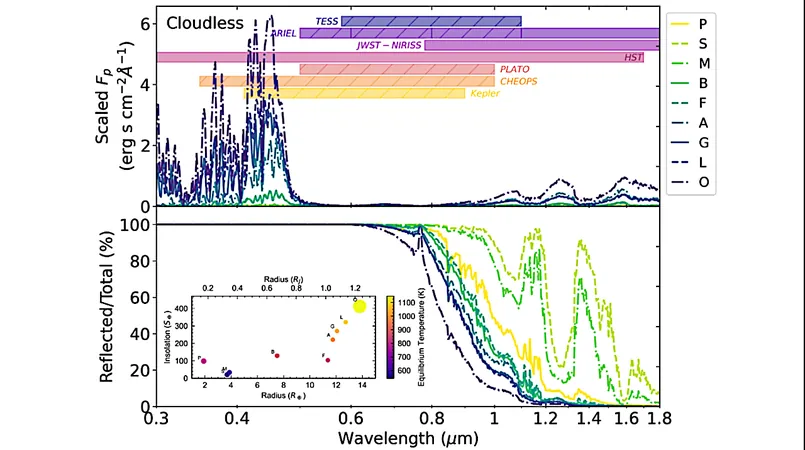
Revolutionary Algorithm Unleashes Hidden Potential of Mass Spectrometry Data to Identify Unknown Pollutants
2025-05-19
Author: Arjun
Unlocking Environmental Insights with MassQL
Imagine if scientists could easily identify unknown pollutants lurking in our environment. Thanks to a groundbreaking new tool developed at UC Riverside, this is now a reality. Their innovative algorithm harnesses the power of untargeted mass spectrometry, turning previously unclassified chemicals into identifiable entities.
The Challenge of Vast Data
Environmental monitoring professionals have long struggled with a wealth of data that often feels untouchable. Mass spectrometry, a powerful method for analyzing complex environmental samples, generates enormous datasets that are frequently underutilized. Conventional tools typically fall short, lacking the scalability and accessibility needed to fully explore this valuable information.
Introducing MassQL: A Game-Changer for Scientists
Enter the Mass Spectrometry Query Language, or MassQL. This innovative programming language allows researchers to dig deep into mass spectrometry datasets with unprecedented speed and accuracy, all without requiring them to be coding experts. With MassQL, scientists can now define custom molecular patterns and conduct targeted searches across vast oceans of data.
Empowering Non-Coders
In the past, mining mass spectrometry data required specialized bioinformatics knowledge, excluding many chemists and biologists from extracting valuable insights from their own work. MassQL removes these barriers, functioning like a powerful search engine for chemical data and enabling users to harness their data without having to become programming whizzes.
Rapidly Discovering Pollutants
Environmental scientists are already experiencing the profound effectiveness of MassQL. In a notable project published in Nature Methods, UCR researcher Nina Zhao leveraged MassQL to sift through extensive public mass spectrometry data from global water samples. Her mission? Identify the potentially harmful organophosphate esters, widely used in flame retardants and plastics.
Thanks to MassQL, Zhao was able not only to pinpoint known compounds but also uncover new derivatives and degradation products — many of which pose serious risks to human health and ecosystems.
Beyond Pollutant Identification
One of MassQL's remarkable strengths is its versatile application. Already integrated into various open-source and commercial mass spectrometry platforms, it has transformed environmental and biomedical analysis, enhancing interoperability and reproducibility. From tracking 'forever chemicals' like PFAS to discovering new antibiotics, MassQL is reshaping the way scientists approach chemical data.
A Tool for Today’s Challenges
MassQL stands poised to become an essential asset for environmental monitoring professionals. This tool allows for rapid identification of unknown compounds, reanalysis of legacy data with fresh hypotheses, and systematic querying across diverse samples — all while promoting transparency and reproducibility in workflows.
Lead developer Mingxun Wang expresses his excitement, stating, 'I wanted to create one language that could handle multiple kinds of queries. Now we have it, and I'm eager to see the discoveries that emerge.'
A New Era for Pollution Monitoring
As the pressure to identify and address emerging contaminants intensifies, MassQL represents a significant leap forward. By placing advanced data mining capabilities in the hands of those who need them most, it paves the way for new discoveries and innovations in pollution tracking and chemical safety.
MassQL is not just a tool; it's a revolution in how we understand and tackle environmental challenges.




 Brasil (PT)
Brasil (PT)
 Canada (EN)
Canada (EN)
 Chile (ES)
Chile (ES)
 Česko (CS)
Česko (CS)
 대한민국 (KO)
대한민국 (KO)
 España (ES)
España (ES)
 France (FR)
France (FR)
 Hong Kong (EN)
Hong Kong (EN)
 Italia (IT)
Italia (IT)
 日本 (JA)
日本 (JA)
 Magyarország (HU)
Magyarország (HU)
 Norge (NO)
Norge (NO)
 Polska (PL)
Polska (PL)
 Schweiz (DE)
Schweiz (DE)
 Singapore (EN)
Singapore (EN)
 Sverige (SV)
Sverige (SV)
 Suomi (FI)
Suomi (FI)
 Türkiye (TR)
Türkiye (TR)
 الإمارات العربية المتحدة (AR)
الإمارات العربية المتحدة (AR)